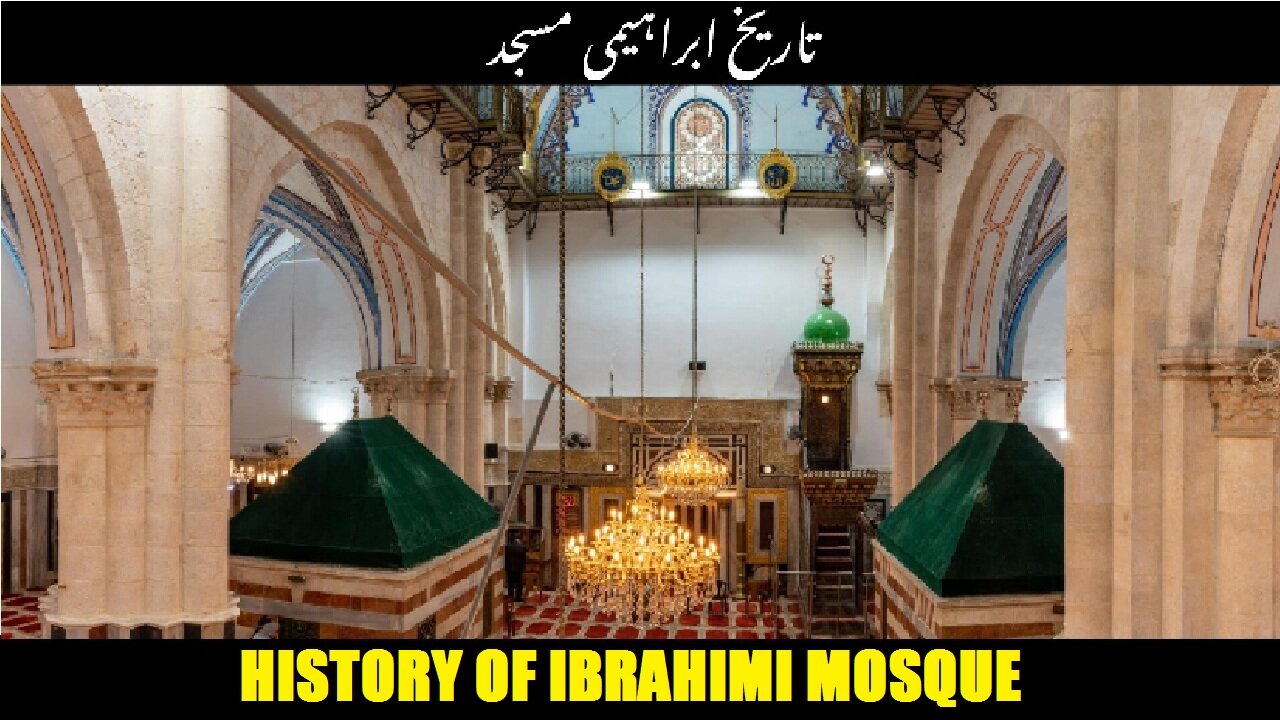Premium Only Content

History of Ibrahimi Mosque | تاریخ مسجد ابراہیمی
@islamichistory813 #IbrahimiMosqueHistory #CulturalHeritage #holiestsites
History of Ibrahimi Mosque in Hebron, West Bank, Palestine
Asslamoalaikum sisters brothers friends and elders, We are describing the captivating history of the Ibrahimi Mosque in Hebron, West Bank, Palestine with this history of Holiest places islamic informative video. Gain a deeper understanding of the mosque's religious and cultural significance, as well as its architectural and historical importance. The video also sheds light on the ongoing political and social complexities surrounding the mosque, will offering viewers a comprehensive look at this iconic landmark.
Al Ibrahimi Mosque in Hebron is the world’s oldest sacred building still in use today in a practically continuous manner. It is believed to hold the remains of God’s prophet Abraham, his wife Sarah, their son Isaac and grandson Jacob, and their wives Rebecca and Leah. The sanctity of the site has contributed to the cultural endurance of Hebron.
It has made the town renowned the world over, giving its name to other places around the world, in the United Kingdom and the United States. It is not certain when the site became sacred. History books do not cover its history much before the Roman era. It is not known when the burial site of the Patriarchs was defined and when its sanctity started to spread. Its sacred status could go back to several centuries BC, with an enormous historical gap remaining between Abraham’s time on earth in the 17th Century BC and the Roman era, i.e. a gap of more than a thousand years. No one can know what happened during that time, especially as the ruins shed no light on the events that took place there.
The current structure is composed of a large enclosure built around a double-chamber cave. There are doubts shrouding even the origin of the enclosure. The Roman historian Josephus (approx. 37 – 100 AD) had listed all structures built by King Herod (rexit: 37–4 BC). However, the site was not on his list and nothing in his writings linked the structure to Herod. Nevertheless, the enclosure’s architecture is undoubtedly Herodian. The structure features the use of large stone blocks the length of which can exceed many meters (7.5 m for the longest), with a height of over one meter (1.4 m for the tallest). A number of archeologists (such as Conder, Betzinger, Robinson, Warren and Heidet) even maintain that the enclosure was built long before Herod’s reign. It should be noted that, despite the structure’s scale and exceptional longevity – in excess of 2000 years, and despite the many powerful earthquakes experienced by the region, it has not lost it stability and has never sustained damage that required restoration. Its stones are finely hewn, with a 10-cm-wide margin surrounding each of them. The original enclosure is a 16m-high southeast-oriented roofless rectangular structure (59.28 m x 33.97 m). Walls are 2.68-meter thick. Each wall consists of two parts. The lower courses are made of normal large and tall stone blocks, while the upper part features a total of 48 protruding square columns (16 on each of the long walls and 8 on each of the short walls), as well as smaller recessed areas between them near the corners. These pilasters increase the structure’s strength and add to it an aesthetic touch that contrasts with the monotony of the lower section’s flat surface. On top of each wall, several clay-plastered courses were added at later times (probably under the Ottomans). This section of the wall was stripped during the last renovation effort and the edges of its stones were lined.
The focal point of Hebron for most visitors is the Tomb of the Patriarchs (Cave of Machpelah), known to Muslims as Ibrahimi Mosque (Ibrahim is the Muslim name for Abraham). The site is sacred to both Muslims and Jews – be aware of the strict security and separate prayer spaces for each. When coming from the Old City, you will need to pass through an Israeli checkpoint and show your passport.
Looking rather like decorated tents, the mostly Mamluk-era cenotaphs commemorate the patriarchs Abraham, Isaac and Jacob, and their wives, but it’s the cave below that both Jews and Muslims believe was chosen by Abraham as the actual final resting place of his family.
You can peer into the cave through a metal grate in the corner of the mosque. As you walk into the room that allows viewing of the cenotaph of Abraham, note the small niche near the door where you can see a footprint. The Muslims believe this to be Muhammad's footprint, while Jews believe it was created by Adam.
Built by Herod (notice the Herodian stones at the base of the walls), the complex was altered by the Byzantines in the 6th century – they added a church, beside which a synagogue was built. When the Arabs conquered the area in the following century, the church was converted to a mosque, but the synagogue remained intact. After the Crusaders left the scene, the Mamluks built another mosque.
When entering the mosque, you will be asked to remove your shoes, and women will be handed a head covering. When entering the synagogue, men will be offered kippas and women a scarf to cover their shoulders
So friends, tomorow inshahAllah same time, will be described, History of Tomb of Hazrat Daniyal (AS) in Susa, Iran, West Bank, Palestine. Allah Hafiz
===============================
-
 2:03:03
2:03:03
The Connect: With Johnny Mitchell
15 hours ago $2.91 earnedHow Mexican & Chinese Cartels Control Illegal Marijuana Cultivation In America Using SLAVE Labor
14.4K3 -
 14:46
14:46
Mrgunsngear
17 hours ago $1.58 earnedPrimary Arms GLx 1x Prism With ACSS Reticle Review
16.3K7 -
 22:37
22:37
Degenerate Plays
16 hours ago $0.20 earnedI'm A Psychic Now - Elden Ring : Part 73
8.29K -
 2:32:02
2:32:02
Jamie Kennedy
9 hours agoEp. 195 Horror Legend Barbara Crampton
13.3K1 -
 23:00
23:00
Exploring With Nug
1 day ago $33.26 earnedHis Truck Was Found Crashed in the Woods… But He’s Gone!
141K8 -
 27:09
27:09
MYLUNCHBREAK CHANNEL PAGE
1 day agoDilmun: Where Life Never Ends
106K67 -
 2:58:32
2:58:32
Slightly Offensive
20 hours ago $113.46 earnedHas Trump FAILED US? The ABSOLUTE STATE of The Right Wing | Guest: Nick Fuentes
157K221 -
 1:37:05
1:37:05
AlaskanBallistics
15 hours ago $4.64 earnedI Love This Gun PodCast #16
60K4 -
 2:59:26
2:59:26
Twins Pod
1 day agoEMERGENCY PODCAST WITH ANDREW TATE! - Twins Pod - Special Episode - Andrew Tate
220K238 -
 2:52:01
2:52:01
Jewels Jones Live ®
2 days agoTRUMP SECURES BORDER | A Political Rendezvous - Ep. 113
120K39